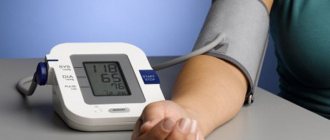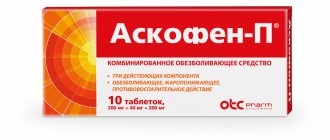Pharmacological properties of the drug Liprazide
A combination antihypertensive drug that contains an ACE inhibitor (lisinopril) and a thiazide diuretic (hydrochlorothiazide). Lisinopril blocks the formation of angiotensin II, which reduces its vasoconstrictor effect, as well as its stimulating effect on aldosterone production in the adrenal glands. As the drug acts, blood pressure decreases, peripheral vascular resistance decreases, preload on the heart decreases, pressure in the pulmonary circulation decreases, and intrarenal circulation slightly increases. Lisinopril has virtually no effect on heart rate and IOC. Hydrochlorothiazide has diuretic and natriuric effects and potentiates the antihypertensive effect of lisinopril. The duration of the antihypertensive effect of Liprazide is 36 hours after a single dose. After oral administration, the maximum concentration of lisinopril in the blood serum is achieved after 6–7 hours. Bioavailability is 25–50%. Lisinopril practically does not bind to plasma proteins and is not metabolized in the body; it is excreted unchanged in the urine. The half-life is at least 12.6 hours, the period of complete elimination is 30 hours. The hypotensive effect is observed within 1 hour after administration and persists for 24 hours. Food intake does not affect absorption rates. In case of impaired renal function, a decrease in the excretion of lisinopril is observed (this decrease becomes clinically important when the glomerular filtration rate is below 30 ml/min). In elderly patients, the renal clearance of the drug may change. The hypotensive effect of lisinopril persists with prolonged use; with abrupt cessation of lisinopril therapy, withdrawal syndrome does not develop. Hydrochlorothiazide after oral administration is absorbed by 60–80%. The maximum concentration in blood plasma is observed after 1.5–3 hours. Hydrochlorothiazide is poorly metabolized. Excretion of hydrochlorothiazide in patients with unchanged renal function occurs almost exclusively in the urine. About 50–75% of the dose administered orally is excreted unchanged in the urine. In elderly patients and in patients with impaired renal function, the clearance of hydrochlorothiazide is significantly reduced, which leads to a significant increase in its concentration in the blood plasma. In patients with liver cirrhosis, no changes in the pharmacokinetics of hydrochlorothiazide are observed.
Compound
- 1 tablet of Liprazide 10 contains 12.5 mg of hydrochlorothiazide and 10 mg of lisinopril. Additional substances: corn starch, mannitol, yellow iron oxide, magnesium stearate, calcium hydrogen phosphate dihydrate.
- 1 tablet of Liprazide 20 contains 12.5 mg of hydrochlorothiazide and 20 mg of lisinopril. Additional substances: corn starch, mannitol, yellow iron oxide, magnesium stearate, calcium hydrogen phosphate dihydrate.
Side effects of the drug Liprazide
Rarely require discontinuation of treatment. Possible dry cough, dizziness, headache, feeling of fatigue, nausea, less often - orthostatic hypotension, asthenia, skin rash of allergic origin, tachycardia, abdominal pain, diarrhea, dry mouth. In some cases - Quincke's edema, mood lability, confusion, impaired renal function, impotence, hyperkalemia, increased activity of liver transaminases, increased concentrations of creatinine, bilirubin in the blood serum, neutropenia, agranulocytosis, decreased levels of hemoglobin and red blood cells. Cases of the development of acute renal failure, arthralgia, myalgia, and fever have been described. With prolonged use, hypokalemia, hyponatremia, muscle weakness, and delayed nitrogen excretion in the form of uric acid may develop.
Price, where to buy
The price of Liprazid 10 No. 30 in Ukraine is about 64 hryvnia, and in Russia the price of a similar package is close to 306 rubles.
- Online pharmacies in UkraineUkraine
Pharmacy24
- Liprazide 20 No. 30 tablets PAT NEC "Borshchagivsky chemical and pharmaceutical plant", Kiev, Ukraine
66 UAH. order - Liprazide 10 N30 tablets PAT NEC "Borshchagivsky chemical and pharmaceutical plant", Kiev, Ukraine
50 UAH order
Special instructions for the use of Liprazide
In case of renovascular hypertension (arterial hypertension), some patients, especially with bilateral renal artery stenosis or with stenosis of the artery of a single kidney, may experience a pronounced hypotensive effect, especially after taking the first dose of Liprazide, therefore the recommended initial dose of the drug is 2.5 or 5 mg (in terms of lisinopril). Taking diuretics should be stopped 2-3 days before Liprazide is prescribed. If this is not possible, the initial dose of the drug should not exceed 5 mg (in terms of lisinopril) due to the possible development of arterial hypotension. The drug is prescribed with caution to patients with gout, with impaired liver function and patients with diabetes mellitus, especially those receiving insulin or oral hypoglycemic agents. There is no experience of use in children.
Liprazid 10 tablets 10mg/12.5mg No. 10x3
Name
Liprazid 10 tablets 10 mg 12.5 mg in blisters in pack No. 10x3
Basic physical and chemical properties
Liprazid 10 is a round tablet with a biconvex surface, light yellow in color with a brownish tint. Marbling and inclusions from yellow to brown are allowed on the surface of the tablets. Liprazid 20 is a round tablet with a biconvex surface, pink in color. Marbling and inclusions of red-brown color are allowed on the surface of the tablets.
Compound
active ingredients: lisinopril and hydrochlorothiazide; composition: 1 tablet of Liprazide 10 contains lisinopril - 10 mg, which corresponds to lisinopril dihydrate - 10.89 mg and hydrochlorothiazide - 12.5 mg; 1 tablet of Liprazide 20 contains lisinopril - 20 mg, which corresponds to lisinopril dihydrate - 21.78 mg and hydrochlorothiazide - 12.5 mg; excipients: Liprazide 10 - mannitol (E 421), corn starch, magnesium stearate, yellow iron oxide (E 172), calcium hydrogen phosphate dihydrate. Liprazide 20 - mannitol (E 421), corn starch, magnesium stearate, red iron oxide (E 172), calcium hydrogen phosphate dihydrate.
Pharmacotherapeutic group
Drugs affecting the renin-angiotensin system. ACE inhibitors in combination with other drugs. ACE inhibitors and diuretics. ATS code C09B A03.
Indications
Mild to moderate arterial hypertension in patients whose condition is already adequately controlled by simultaneous administration of lisinopril and hydrochlorothiazide in the same doses as Liprazide.
Contraindications
- Hypersensitivity to lisinopril, hydrochlorothiazide, other components of the drug or other ACE inhibitors;
- hypersensitivity to sulfonamide derivatives;
- history of hereditary or idiopathic angioedema (Quincke's edema);
- history of angioedema caused by taking ACE inhibitors;
- bilateral renal artery stenosis or renal artery stenosis of a single kidney;
- mitral or aortic stenosis, hypertrophic cardiomyopathy with severe hemodynamic disturbances;
- acute myocardial infarction with unstable hemodynamics;
- cardiogenic shock;
- severe renal (creatinine clearance
- condition after kidney transplantation;
- mechanical obstruction of the urinary tract;
- hemodialysis using high-strength membranes;
- disturbances of water-salt metabolism (hyperkalemia/hypokalemia, hyponatremia, hypovolemia);
- severe forms of diabetes mellitus;
- severe liver failure, hepatic encephalopathy;
- primary hyperaldosteronism;
- exacerbation of gout;
- porphyria;
- anuria;
- simultaneous use with aliskiren-containing drugs in patients with diabetes mellitus (type I or II) or
- moderate/severe renal failure (GFR)
pregnancy.
Precautionary measures
Non-melanoma skin cancer. Increased risk of non-melanoma skin cancer (NMSC)
basal cell carcinoma (BCC) and squamous cell carcinoma (SCC)
with increasing cumulative dose of hydrochlorothiazide was demonstrated in two pharmacoepidemiological studies based on data from the Danish National Cancer Registry. The photosensitizing effect of hydrochlorothiazide may act as a possible mechanism for the development of this pathology. Patients taking hydrochlorothiazide alone or in combination with other drugs should be informed of the risk of developing NMSC, especially with long-term use, the need for regular skin checks, and to promptly report any suspicious skin growths, any changes in skin lesions or moles . To reduce the risk of developing skin cancer, patients should be advised of possible preventative measures, such as limiting exposure to sunlight and UV radiation, and if exposed, the need for adequate skin protection. It is necessary to examine suspicious skin lesions as soon as possible, including histological examination of biopsy material. Patients with a history of NMSC may also need to reconsider the use of hydrochlorothiazide. Symptomatic hypotension and previous treatment with diuretics. In patients with dehydration and electrolyte imbalance due to previous diuretic treatment, or with dehydration of a different origin (excessive sweating, prolonged vomiting, profuse diarrhea), symptomatic arterial hypotension may occur after taking Liprazide. To prevent it, the use of diuretics must be stopped 2-3 days before starting Liprazide treatment. If this is not possible, treatment should begin with a dose of 5 mg (in terms of lisinopril). In patients at increased risk of symptomatic hypotension, treatment should be initiated under medical supervision and with periodic monitoring of serum electrolyte levels. In case of arterial hypotension, the patient should be in a supine position, and if necessary, saline solution should be administered intravenously. A temporary hypotensive reaction is not a contraindication to further treatment. To further restore effective blood volume and blood pressure (BP), it is necessary to reduce the dose or switch to monotherapy with one of the active components of the drug. When changing the dose, monitoring should be especially careful. Electrolyte imbalance. As with any diuretic treatment, patients should periodically determine serum electrolyte levels. Thiazides, including hydrochlorothiazide, can cause water and electrolyte imbalance (hypokalemia, hyponatremia, hypochloremic alkalosis). Symptoms of water and electrolyte imbalance include dry mouth, thirst, weakness, lethargy, drowsiness, restlessness, muscle pain or cramps, muscle weakness, hypotension, oliguria, tachycardia, and gastrointestinal disorders such as nausea and vomiting. In hot weather, patients prone to edema may develop hyponatremia. Chloride deficiency is usually mild and does not require treatment. Thiazides may increase renal excretion of magnesium, which may lead to hypomagnesemia. Aortic stenosis/hypertrophic cardiomyopathy. ACE inhibitors should be prescribed with caution to patients with left ventricular outflow tract obstruction. Prescribe with caution to patients with coronary heart disease or cerebrovascular disease, since a pronounced decrease in blood pressure can cause myocardial infarction or cerebrovascular stroke. Surgery/general anesthesia. Caution should be exercised when using Liprazide in patients who are planning to undergo surgery under anesthesia, since during major surgical interventions and the use of other drugs that cause a decrease in blood pressure, lisinopril, by blocking the formation of angiotensin II, can cause a pronounced, unpredictable decrease in blood pressure. Hypotension of this origin can be eliminated by compensation of intravascular fluid. Metabolic and endocrine effects. Thiazide therapy may reduce glucose tolerance. Doses of antidiabetic agents, including insulin, may need to be adjusted. Thiazides may reduce urinary calcium excretion and cause a transient and slight increase in serum calcium. Hypercalcemia may indicate hidden hyperparathyroidism. Thiazides should be discontinued before parathyroid function tests are performed. Increases in cholesterol and triglyceride levels may be associated with thiazide diuretic therapy. Thiazide diuretic therapy may precipitate hyperuricemia and/or gout in some patients. However, lisinopril may increase the excretion of uric acid and thus may reduce the hyperuricemic effect of hydrochlorothiazide. Patients with diabetes mellitus. In diabetic patients taking oral antidiabetic agents or insulin, careful glycemic control should be exercised, especially during the first month of ACE inhibitor therapy. Manifestation of latent diabetes is possible. Hypersensitivity/angioedema. Angioedema of the face, upper and lower extremities, lips, tongue, epiglottis and/or larynx has rarely been reported in patients taking ACE inhibitors, including lisinopril. This can happen at any time during therapy. In such cases, the use of Liprazide should be stopped immediately, appropriate treatment should be administered and the patient should be closely monitored until symptoms disappear completely. Even in cases where swelling is limited only to the tongue and there are no signs of respiratory distress, the patient's condition should be monitored, since treatment with antihistamines and corticosteroids may not be sufficient. Very rarely, deaths due to angioedema of the larynx or tongue have been reported. If swelling extends to the tongue, vocal cords, or larynx, airway obstruction may occur, especially in patients who have previously undergone respiratory surgery. In such cases, it is necessary to take emergency treatment measures (administration of adrenaline (epinephrine) and/or maintaining airway patency). The patient should be under medical supervision until symptoms disappear completely and permanently. Patients with a history of angioedema not related to ACE inhibitor therapy may be at risk of developing angioedema while receiving an ACE inhibitor. Patients receiving thiazide therapy may experience hypersensitivity reactions (with or without a history of allergies or asthma). The use of the drug may worsen the course of connective tissue diseases, including systemic lupus erythematosus. Patients on hemodialysis. The use of lisinopril/hydrochlorothiazide is not indicated in patients with renal failure requiring hemodialysis. It is also not prescribed to patients with a transplanted kidney. The development of anaphylactic reactions has been reported in patients who underwent hemodialysis using high-precision membranes (for example AN 69) and simultaneously used ACE inhibitors. These patients may need to use a different type of dialysis membrane or a different class of antihypertensive drug. Anaphylactoid reactions during low-density lipoprotein (LDL) apheresis. Life-threatening anaphylactoid reactions have rarely developed in patients treated with ACE inhibitors during low-density lipoprotein (LDL) apheresis using dextran sulfate absorption. To avoid these reactions, ACE inhibitors should be suspended before each apheresis procedure. Anaphylactoid reactions during desensitizing therapy. Patients receiving ACE inhibitors during desensitization with an allergen from hymenoptera venom (for example, bee venom) developed anaphylactoid reactions. If such patients refrained from taking ACE inhibitors during desensitization, no reactions were observed, but accidental administration of ACE inhibitors provoked anaphylactoid reactions. Cough. A nonproductive/persistent cough is characteristic, which is observed when taking ACE inhibitors and disappears after discontinuation of therapy. Cough caused by an ACE inhibitor must be differentiated from cough caused by other diseases. Salt-free diet. The drug should be prescribed with caution to patients on a salt-free diet. Renal dysfunction. Thiazides may be inappropriate diuretics for use in patients with renal impairment and are ineffective when creatinine clearance is 30 mL/min or lower (moderate to severe renal impairment). Liprazide should not be administered to patients with renal impairment (creatinine clearance less than 80 ml/min), unless dose titration of the individual active substances of the drug is used to achieve an acceptable dose that is present in the combination. Some patients with arterial hypertension without obvious signs of damage to the blood vessels of the kidneys may experience a slight temporary increase in serum urea and creatinine levels, especially when lisinopril was used concomitantly with diuretics. This occurs more often in patients with pre-existing kidney dysfunction. This condition requires dose reduction and/or discontinuation of the diuretic and/or Liprazide. In some patients with bilateral renal artery stenosis or renal artery stenosis of a solitary kidney, ACE inhibitors increase blood urea and creatinine levels; blood serum; Typically, these effects disappear after stopping the medications. The likelihood of such events is especially high in patients with renal failure. The presence of renovascular hypertension increases the risk of developing severe arterial hypotension and renal failure. Treatment of such patients should begin under medical supervision with low doses and subsequently with careful titration of the dose. Since diuretics may precipitate the condition described above, renal function should be carefully monitored during the first weeks of treatment with lisinopril/hydrochlorothiazide. Liver diseases. Thiazides should be used with caution in patients with impaired liver function or progressive liver disease, since minor changes in water-salt and electrolyte balance can cause sudden hepatic coma. Very rarely, a syndrome that begins with cholestatic jaundice or hepatitis and progresses to liver necrosis, sometimes fatal, has been associated with the use of ACE inhibitors. The mechanism of this syndrome is unknown. If patients taking ACE inhibitors develop jaundice or significantly increase the activity of liver enzymes, the drug should be discontinued and the patient should be kept under medical supervision until symptoms disappear. Elderly persons. Treatment begins with the lower limit of the dose of Liprazide (10 mg + 12.5 mg) due to the fact that the likelihood of deterioration in liver, kidney and heart function is higher due to concomitant diseases and the use of other medications. When selecting doses, safety precautions (monitoring renal function) should be observed. Neutropenia/agranulocytosis. Neutropenia/agranulocytosis, thrombocytopenia and anemia may develop in patients taking ACE inhibitors. With normal renal function and in the absence of complications, neutropenia rarely develops. Neutropenia and agranulocytosis are reversible and disappear after discontinuation of ACE inhibitors. Liprazide should be used with particular caution in patients with connective tissue disease with vascular manifestations, those receiving treatment with immunosuppressants, allopurinol or procainamide, or a combination of these factors, especially in the presence of pre-existing renal impairment. Some of these patients develop severe infections that sometimes do not respond to intensive antibiotic therapy. When using Liprazide in this group of patients, periodic monitoring of leukocytes is recommended, and the patient should be warned about the need to inform the doctor of any signs of infection. Hyperkalemia. In some patients, when taking ACE inhibitors, including lisinopril, an increase in serum potassium concentrations was noted. Risk factors for hyperkalemia include renal failure or diabetes mellitus, concomitant use of potassium-sparing diuretics, dietary supplements containing potassium or potassium salt substitutes, or other drugs that cause an increase in serum potassium concentrations (eg, heparin). If taking the above drugs during treatment with ACE inhibitors is determined to be necessary, regular monitoring of serum potassium levels is recommended. Lithium. Concomitant use of lithium and lisinopril is generally not recommended. Double blockade of the renin-angiotensin-aldosterone system (RAAS). Double blockade of the RAAS with simultaneous use of ACE inhibitors (ACEIs), angiotensin II receptor blockers (ARBs), direct renin inhibitors (for example, aliskiren) is associated with an increased risk of arterial hypotension, hyperkalemia, and renal dysfunction (including acute renal disease). failure) compared to monotherapy. If this combination is necessary, blood pressure, renal function and blood electrolytes should be carefully monitored in patients taking lisinopril and other drugs that affect the RAAS. The use of aliskiren in combination with an ARB II or ACEI is contraindicated in patients with diabetes mellitus or impaired renal function (GFR
The ability to influence the reaction rate when driving a vehicle or working with other mechanisms
Due to the risk of adverse reactions such as dizziness (especially at the beginning of treatment), confusion, and arterial hypotension, it is not recommended to drive vehicles or operate other mechanisms until the patient’s individual response is determined.
Interaction with other drugs
Lisinopril with: direct renin inhibitors (for example, aliskiren-containing drugs) ARB II: the risk of developing arterial hypotension, hyperkalemia, and renal dysfunction (including acute renal failure) increases. Combination of ACE inhibitors, incl. lisinopril, with aliskiren-containing drugs is contraindicated in patients with diabetes mellitus or impaired renal function (GFR
Directions for use and dosage
The drug is prescribed taking into account the doses of lisinopril or hydrochlorothiazide, which were used in monotherapy. The dose and duration of treatment are selected individually depending on the therapeutic effect and severity of the disease. The usual dose is 1 tablet of Liprazide 10 or Liprazide 20 per day. The drug should be taken at approximately the same time every day. If the desired therapeutic effect is not achieved within 2-4 weeks, the dose should be increased to 2 tablets. The maximum daily dose (in terms of lisinopril) is 40 mg. Renal failure Liprazide 10 or Liprazide 20 should not be used as initial therapy in these patients. Thiazides are not usually used in patients with impaired renal function; they are not effective when creatinine clearance is 30 ml/min or lower (i.e., with moderate to severe renal impairment). In patients with creatinine clearance > 30 and
Overdose
Symptoms associated with an overdose of ACE inhibitors: arterial hypotension, circulatory shock, electrolyte disturbances, renal failure, hyperventilation, tachycardia, palpitations, bradycardia, dizziness, anxiety, cough. To treat an overdose, administration of saline is recommended. In case of arterial hypotension, the patient should be placed on his back with his legs elevated. If necessary, infusion of angiotensin II and/or intravenous catecholamines is possible. If the drug has been used recently, measures should be taken to eliminate lisinopril (stimulating vomiting, gastric lavage, administration of absorbents and sodium sulfate). Lisinopril can be removed from the body by hemodialysis. Therapy with cardiac stimulants is indicated in the event of bradycardia that is resistant to treatment with other therapeutic agents. Vital signs, serum electrolyte balance, and creatinine concentrations should be continuously monitored. Symptoms caused by an overdose of hydrochlorothiazide: increased diuresis, depression of consciousness (including coma), convulsions, paresis, arrhythmia, renal failure. Bradycardia or vagal reactions can be eliminated by the use of atropine. In the case of concomitant use of digitalis drugs, hypokalemia may develop, which increases the risk of arrhythmia.
Best before date
3 years. The expiration date is the last day of the month indicated on the packaging. Do not use the drug after the expiration date indicated on the package!
Storage conditions
Store in original packaging to protect from light at temperatures not exceeding 25 °C. If the blister pack is removed from the pack, it must be protected from light. Keep out of the reach of children.
Package
10 tablets in a blister made of polyvinyl chloride film and aluminum foil, coated on one side with thermovarnish and printed on the other side. 3 blisters along with instructions for medical use of the drug in a cardboard pack.
Vacation conditions
On prescription.
Drug interactions Liprazide
The hypotensive effect of Liprazide is enhanced by the simultaneous administration of other antihypertensive drugs. When used simultaneously with potassium-sparing diuretics (spironolactone, triamterene, amiloride), hyperkalemia may develop, and with lithium salts, an increase in the level of lithium in the blood plasma. NSAIDs may reduce the effectiveness of Liprazide when used concomitantly. Liprazide may enhance the effects of alcohol. Hydrochlorothiazide may increase the toxicity of cardiac glycosides, antidepolarizing muscle relaxants, and reduce the effect of oral contraceptives.
Analogs
Level 4 ATX code matches:
Akkuzid
Enap-N
Iruzid
Co-Diroton
Enalozide
Enap NL
Enapril-N
Capozide
Tritace Plus
Enzix
Co-Renitec
Hartil N
Hartil D
Noliprel
Ko-Perineva
Kaptopres
Iruzid, Co-Diroton, Lisinopril, Lisopress, Lisoretic, Lisothiazide, Lopril Bosnalek.
Overdose
Symptoms: acute arterial hypotension, headache, drowsiness, dizziness, anxiety, fatigue, weakness, impaired consciousness, dry mouth, cough, thirst, nausea, vomiting, hyperventilation, tachycardia, bradycardia, cardiac arrhythmia, cardiovascular shock, spasms/convulsions of the calf muscles, paresthesia, disturbances in water-electrolyte balance and acid-base balance (dehydration, hypokalemia, hyponatremia, hypochloremia, alkalosis), increased levels of urea nitrogen in the blood (especially in patients with renal failure), opn.
Treatment: symptomatic and supportive therapy, there is no specific antidote. Gastric lavage is advisable if no more than 4 hours have passed since taking the drug. If necessary, provide access to oxygen or perform artificial respiration. Correction of water and electrolyte balance is indicated with monitoring of laboratory indicators of renal function until they are normalized.
In case of hypotension, the patient is transferred to a lying position with the lower limbs elevated, and an intravenous infusion of isotonic sodium chloride solution is given. Lisinopril is eliminated during hemodialysis, but the use of high-flow polyacrylonitrile membranes for dialysis and hemofiltration should be avoided due to the risk of anaphylactic reactions. The use of a pacemaker is indicated for the treatment of persistent bradycardia.
If angioedema develops, 0.3–0.5 ml of epinephrine solution should be administered subcutaneously and desensitizing agents should be prescribed. Severe cases of angioedema of the tongue, glottis and pharynx may require maintenance of the upper airway (intubation, tracheotomy).
Note!
Description of the drug Liprazide 10 tablets. No. 30 on this page is a simplified author’s version of the apteka911 website, created on the basis of the instructions for use.
Before purchasing or using the drug, you should consult your doctor and read the manufacturer's original instructions (attached to each package of the drug). Information about the drug is provided for informational purposes only and should not be used as a guide to self-medication. Only a doctor can decide to prescribe the drug, as well as determine the dose and methods of its use.



